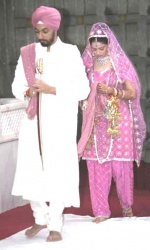Template:AOW144: Difference between revisions
Hari singh (talk | contribs) No edit summary |
Hari singh (talk | contribs) mNo edit summary |
||
| (3 intermediate revisions by the same user not shown) | |||
| Line 3: | Line 3: | ||
{{pm|Image:Laava6-M3.jpg|'''[[Anand Karaj]], Sikh wedding ceremony'''}} | {{pm|Image:Laava6-M3.jpg|'''[[Anand Karaj]], Sikh wedding ceremony'''}} | ||
'''[[Anand Karaj]]''' is the name given to the [[Sikh]] wedding [[Sanskar|ceremony]], literally translated as ''"Blissful | '''[[Anand Karaj]]''' ([[Punjabi]]: ਅਨੰਦ ਕਾਰਜ, ''anand kāraj'') is the name given to the [[Sikh]] wedding [[Sanskar|ceremony]], literally translated as ''"Blissful Event"''. | ||
Sikhs regard [[Anand karaj|marriage]] as a sacred bond of mutual dependence between a man and a woman; a true partnership of equals in marriage is made between those who are united in spirit as well as in mind and body. | |||
The [[Laava]], or four stanzas, are read and then sung during the ceremony to formalize and sanctify the marriage. The [[Sikh]] [[religious wedding ceremony]], which almost always these days takes place in a [[Gurdwara]], the Sikh place of worship is held in the presence of [[Sri Guru Granth Sahib]], the [[Sikh holy scripture]] and the [[Sadh sangat]], the holy congregation. | Marriage is regarded as a strong lifetime bond between the bride and groom and and a union between both the families of the bride and groom. | ||
Based on the concept depicted in [[Laava]], the Sikh marriage is not merely a physical and legal contract but is intended to be a fusion of the souls; a holy union between two souls, where physically they appear as two individual bodies but in fact are united as one both spiritually and in thinking. The couple must feel and think alike and both must identify with the other, i.e. they need to become ''"Ek Jot Doe Murti"'' meaning ''"[http://www.srigranth.org/servlet/gurbani.gurbani?Action=Page&Param=788&english=t&id=33639#l33639 one spirit in two bodies]"''. | |||
The [[Laava]], or four stanzas, are read and then sung during the ceremony to formalize and sanctify the marriage. <!--- The [[Sikh]] [[religious wedding ceremony]], which almost always these days takes place in a [[Gurdwara]], the Sikh place of worship is held in the presence of [[Sri Guru Granth Sahib]], the [[Sikh holy scripture]] and the [[Sadh sangat]], the holy congregation. This arrangement offers a way to bring family support into the lives of the couple if they require it. [[Guru Ram Das]], the fourth [[Guru]] of the Sikhs has given, in the four rounds or [[Laava]], a formula for a successful marriage. These four [[Shabad]]s, describe the sacred journey of the soul through this world to the final destination, the merging with the infinite. If one follows this sacred path and applies it properly to the institution of marriage, it should results in happiness and fulfilment – [[Anand]] (Bliss).---> {{aowf|Anand Karaj}} | |||
Latest revision as of 19:42, 5 April 2015

Anand Karaj (Punjabi: ਅਨੰਦ ਕਾਰਜ, anand kāraj) is the name given to the Sikh wedding ceremony, literally translated as "Blissful Event".
Sikhs regard marriage as a sacred bond of mutual dependence between a man and a woman; a true partnership of equals in marriage is made between those who are united in spirit as well as in mind and body.
Marriage is regarded as a strong lifetime bond between the bride and groom and and a union between both the families of the bride and groom.
Based on the concept depicted in Laava, the Sikh marriage is not merely a physical and legal contract but is intended to be a fusion of the souls; a holy union between two souls, where physically they appear as two individual bodies but in fact are united as one both spiritually and in thinking. The couple must feel and think alike and both must identify with the other, i.e. they need to become "Ek Jot Doe Murti" meaning "one spirit in two bodies".
The Laava, or four stanzas, are read and then sung during the ceremony to formalize and sanctify the marriage. .....More
